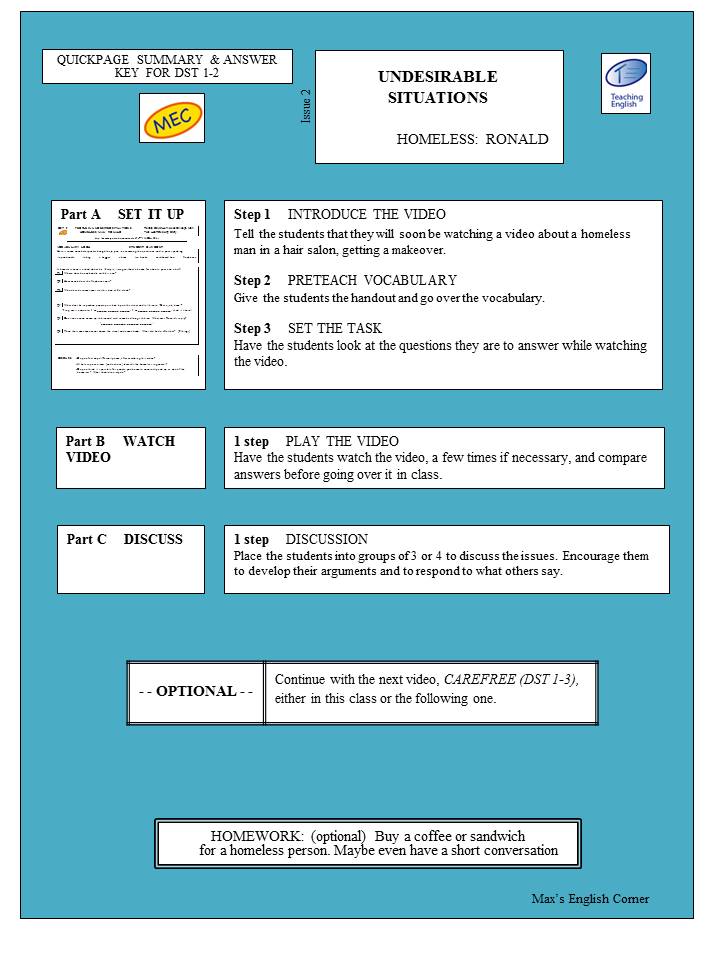Dessert 1-2 / UNDESIRABLE SITUATIONS / 1 Class, Optional: Day 2 of 3
THEME & FOCUS SUMMARY
- Second of 3 videos, looking at people in undesirable situations
(Any of the 3 videos can be done on their own) - Students learn vocabulary, watch video, answer questions and follow up with a discussion
STEP SUMMARY
|
A |
Intro / Pre-teach vocab |
|
B |
Ss watch video & answer Qs |
|
C |
Discussion in groups |
REFERENCES
|
Ronald Davis-Homeless Chicago Man, Tells Heartbreaking Story. |
|
|
Ronald is interviewed in the street about how he feels as a homeless person. |
|
RECOMMENDED LEVELS
Intermediate Up
ACTIVITY TIME
30 minutes +
MATERIALS
Handouts for students:
HO2 vocabulary, comprehension
questions & discussion theme
Quickpage
Class Plan
PART A: SETTING IT UP
|
A |
STEP 1 |
SETTING IT UP INTRODUCE THE VIDEO HOMELESS: RONALD |
|
|
a) |
Tell the students that the video is about a homeless man who is being interviewed about how it is to live his lifestyle. So far he has been living in the street for about a year and a half. (It’s not always easy to make out what he says, so you may have to repeat the section(s) and/or provide a little help.) |
||
|
b) |
Ask the class in general or place the students into pairs to briefly (5 minutes) discuss what it might be like to live in the street. You could ask them to consider shelter for the night, getting food & clothing, and what they would do with their time. (You could also encourage them to use certain structures, like the second conditional.) |
||
|
A |
STEP 2 |
SETTING IT UP PRETEACH VOCABULARY HOMELESS: RONALD |
|
|
a) |
Give the students the handout. |
||
|
b) |
Go over the vocabulary (eliciting &/or providing explanations and examples). Some of the vocabulary may have come up in STEP 1, so ask the students to clearly explain the meaning of those words to you. |
||
|
A |
STEP 3 |
SETTING IT UP CONSIDER THE QUESTIONS HOMELESS: RONALD |
||
|
a) |
Have the students look at questions #1-6 |
|||
|
b) |
|
|||
PART B: THE VIDEO
|
B |
STEP 1 |
PLAY THE VIDEO STUDENTS ANSWER QUESTIONS HOMELESS: RONALD |
|
|
a) |
• OPTION 1: Play the video right through twice and have the students answer the questions, compare their answers with the students next to them & go over the answers as a class. |
||
|
OR |
|||
|
a) |
• OPTION 2: Play the video until the answer appears, repeating that section a few times if necessary. After the answer is given by a student (or yourself), play that part again and continue on to the next section. |
||
|
B |
STEP 2 |
REPEAT THE VIDEO OPTIONAL EXTRA LISTENING HOMELESS: RONALD |
|
|
a) |
-optional- You can stop after all 6 questions have been answered and continue on to the discussion, or as the vídeo is short, you can play it one more time so the students can listen for the answers to the questions you have gone over in class. Sometimes students appreciate this, giving them the opportunity to confirm what they have recently covered and to listen with greater clarity. |
||
DST 1-2
NOTE: The original YouTube video cited here is no longer available, but an alternative has been posted.
PART C: DISCUSSION
|
C |
STEP 1 |
DISCUSSION STUDENTS DISCUSS THE 3 THEMES HOMELESS: RONALD |
|
|
a) |
Place the students into group of 3 or 4 and have them discuss the three questions. Encourage them to give reasons for their points of view, to respond to the other people’s comments, and to explore the themes. |
||
|
C |
STEP 2 |
DISCUSSION OPTIONAL (DIFFERENT) FOLLOW-UPS HOMELESS: RONALD |
|
|
a) |
∙Monitor the various groups, taking note of grammatical, lexical and pronunciation difficulties. Write them on the board and go over them with the students after the discussion. ∙After a set time limit of 10 minutes (for example) or after the speaking has reached its peak, elicit different comments and perspectives from the class. ∙Monitor the groups and if you find that there are a number who agree with the statement and a number who don’t, organize them into two teams for a debate. ∙Continue on with the next video and activity, DST #1-3. RECOMMENDATION: If you plan to do all three videos (DST1- 1 to 3: Jesus, Ron & cancer carefree) in the same class, keep it moving and try not to spend more than 15 or 20 minutes on any of them. This will mean cutting down on the time for some of the discussions or even eliminating some of the elicited preparatory work. |
||





